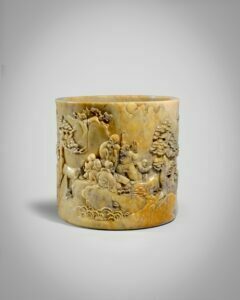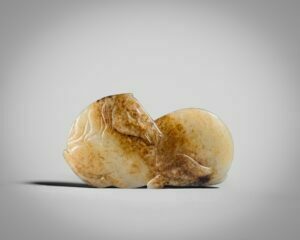

A set of two scrolls, mounted for framing,
ink and colour on silk/ink on coloured paper
Imperial Decree dated twelfth day, sixth month, second year of the Tongzhi period (1863).
Dimensions: 137.5 x 312 cm. (54 1/8 x 122 7/8 in.) / 120.5 x 240.5 cm. (47 3/8 x 94 5/8 in.) (2).
Provenance: Acquired in China in the early 20th century by a European family.
Sold on behalf of a South African client at Christie’s Hong Kong, 01 June 2024 (lot 870) for HK$8,820,000 (Estimate HK$2,000,000-3,000,000).
There are no artist’s signatures found on Capture of the Chief Traitor Shi Dakai. According to the latest research paper authored by Zhang Hongxing, the painting was made under the command of Qingkuan (1848-1927) (see ‘‘Investigating the Date, Maker, and Use of a Set of Photographic Albums of Late Qing Battle Painting’, Orientations 54, no. 5, September/October 2023). There exists two photographic records of this painting: one from a photographic album of the twenty paintings for the victory over the Taiping Rebellion, now in the Special Collection of the Peking University Library (fig. 1) , and the other from another set of photographic albums preserved in the John D. Rockfeller, Jr. Library at Brown University (fig. 2). Further images from the latter set reveal that on the twenty-fifth day, second month, twelfth year of the Guangxu period (1886), Qingkuan led a group of thirteen court painters and set up a painting studio to work on the paintings (fig. 3 & 4). Back in November 1885, the Grand Council was ordered to shortlist twenty battles scenes to be painted to commemorate the Taiping Rebellion. The list was approved by the Empress Dowager Cixi (1835-1908) in 1886 and Prince Chun Yihuan (1840-1891) was appointed Commissioner of the painting project.
Referring to The Content of The Battle Scenes from the Victory over the Taiping Rebellion, Capture of the Chief Traitor Shi Dakai is the sixteenth out of the twenty-paintings series (fig. 5). According to Zhang, Li Hongzhang received order from Yihuan to deliver fifteen paintings, thirteen of which were handled by Zeng Guoquan, and all paintings should be done in two formats: handscroll and album (Zhang Hongxing, ‘Research on Two Groups of Dispersed Late Qing Battlefield Paintings, Palace Museum Journal 94, no. 2, February 2001). Capture of the Chief Traitor Shi Dakai was originally in the format of a handscroll, an enormous one measuring 137.5 cm high that could only fit for a palace.
The colour pigments and silk used for Capture of the Chief Traitor Shi Dakai is of imperial quality and its delicate painting style is similar to that of the imperial military paintings of the Kangxi and Qianlong periods. The Qing imperial army in this painting, led by several named generals and leaders like Luo Bingzhang, Tang Yougeng, Cai Buzhong, Zhang Zhan’ao and Yang Yinggang, encircle the rebels and attack those on the boats and others fleeing to the hinterland. According to the accompanied Imperial Decree as well as a background search of the foregoing names, Capture of the Chief Traitor Shi Dakai depicts the historical event in May 1862 when Luo Bingzhan, the Governor of Sichuan, called on Shi Dakai, one of the leaders of the Taiping Rebellion, to surrender at Dadu River of Hanyuan county.
Capture of the Chief Traitor Shi Dakai and its Imperial Decree are the latest discovery of the Battle Scenes of the Taiping Rebellion Series. A brief version of the Imperial Decree was documented in the Chronicles of Hanyuan County (p.127 refers) which manifests the historical value of this duo.









